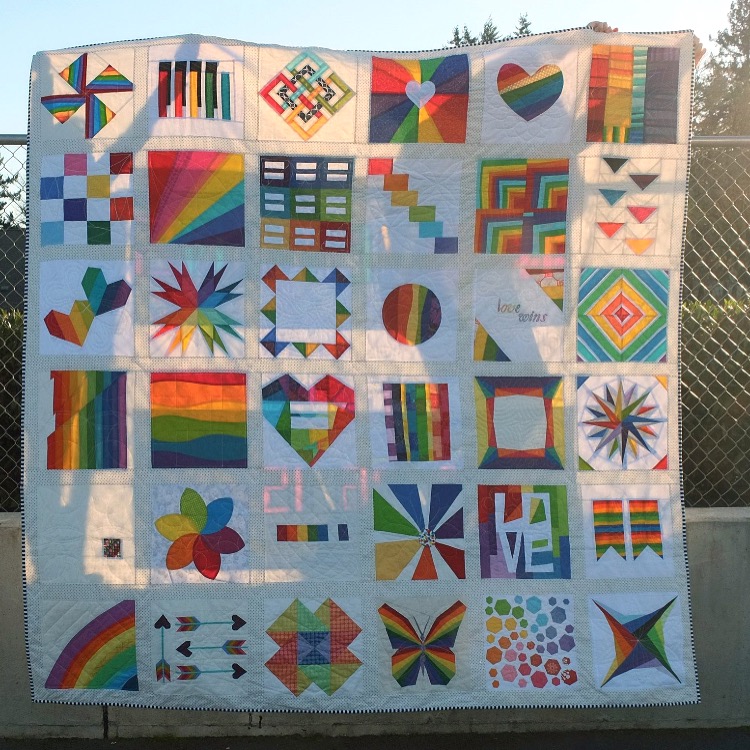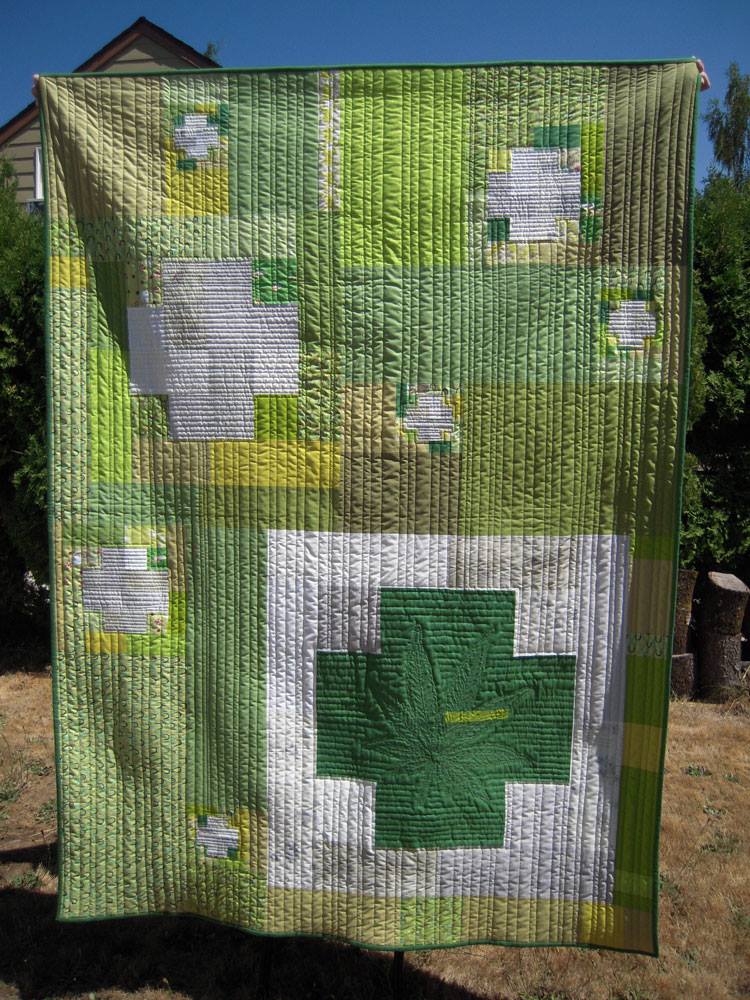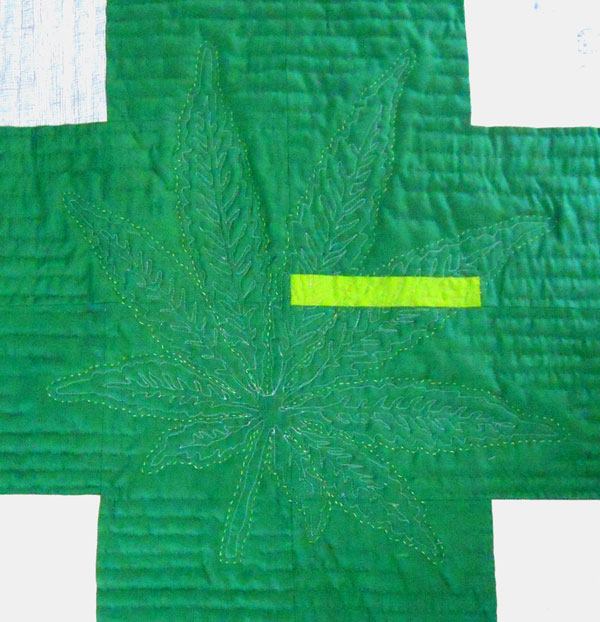There are a lot of reasons to make a quilt. Many get made for the love of making and artistry, others are made for the love of the people they are given to. But sometimes they get made because they are about something bigger than the people involved.
I’d like to share a couple of quilts with you that I think are important from a historical aspect. Fiber has a long history as an appropriate (and appropriated) medium for discussing socio-political topics, so it makes sense that contemporary quilters continue to use needle and thread to give further voice to causes they care about. The quilt history books remember many groundbreaking quilts, and I hope these end up being documented as part of that lineage. Another interesting thing to note: while socio-political quilts often engage feminist ideas, the following examples are notable for not being limited to issues that are solely of interest to women.
As an aside, these quilts were rejected from QuiltCon West 2016. I know about them because I’m in the Portland Modern Quilt Guild, and am so very fortunate to share a community with the artists who made these works. While I realize that QuiltCon cannot possibly accept every quilt offered, I think they are the best venue to create a category in future shows that is invitational and perhaps curated by a quilt historian, which shows the intersection of quilts and socio-political commentary. After all, the MQG aims to be at the cutting edge of contemporary quilting, and I can’t imagine anything more contemporary than art made as statement about the important issues of the day. They have also already displayed several really important works by artists such as Chawne Kimber (scroll down at this link for some of her powerful word quilts) and Jacquie Gering, so I think this could be a natural expansion of mission for them.
And so to the quilts:
First up, #lovewinsquilt: a celebration of love, equality and optimism. Spearheaded by Kristin Link of SewMamaSew, it’s a collaborative effort from 37 quilt artists. I think this quilt is as historic as the Supreme Court decision it celebrates, that of guaranteeing the right to same sex marriage.
In Kristin’s words:
“On the day of the supreme court decision, 6/26/15, I posted on my personal Facebook page, “I can’t get rainbow quilts out of my head, who wants to make a block?” By the end of the day there were dozens of volunteers. Everyone I know who cares about the issue was so high on love that day that I think we all wanted to express it in the best way we know how. I ended up getting 36 blocks exactly, so I put together the top and the back (photo attached in case you haven’t seen it) and then Charlene Trieloff quilted it and sent it back to me to bind. So it really is a big group effort!”
Row 1: Julie McMahon, Susanne Woods, Megan Cavagnaro Dye, Mary Abreu, Gabrien Chaney, Rossie Hutchinson
Row 2: Paloma Link, Mo Bedell, Shea Henderson, MaryAnn Morsette, Heather Jones, Susan Manson
Row 3: Amy Gunson, Elizabeth Dackson, Kristy Daum, Cheryl Arkinson, Laura Harden, Susan Beal
Row 4: Alissa Haight Carlton, Amy Friend, Angela Milliman, Lauren Hawley, Michelle Freedman, Cherie Grzych
Row 5: Heather Givans, Dan Rouse, Becca Jubie, Juline Bajada, Juline Bajada, John Adams
Row 6: Denyse Schmidt, Kristi McDonough, Susan Fuller, Carla Crim, Monica Solorio Snow, Nicole Daksiewicz
Quilted by Charlene Trieloff
Next is Gail Weiss‘s Green Cross Quilt (#cannabisquilt), which celebrates the 2015 legalization of marijuana in Oregon.
Gail wanted to create a sweet, functional object that was in direct juxtaposition to the dark and seedy connotations of violent, drug-dealing crime. The quilt was started before the historic decision, but she hustled to finish it on the date it went into law. The green crosses signify the symbol for marijuana dispensaries (and incidentally, they are the symbol for a standard pharmacy across Europe). Gail said she wanted to make a quilt that was beyond merely pretty, one that meant something. She wanted to use fabric to soften the line between the political and the useful, to make a scary thing (for some) less so.
In Gail’s words:
“Pot is not for everyone, but it’s a wonderful option to pharmaceutical drugs for some people, especially those that have severe reactions to medications.”
Many people get great relief and comfort from pot. I think Gail used the comfort aspect of quilting brilliantly to illustrate the concept of her quilt.
Tomorrow: another important quilt, but for a completely different reason!






These quilts may not be in the QuiltCon program this year, but they are likely to be in history books; two of the most important quilts made in 2015, and among the most socially relevant (so far) in the 21st century.
I’m curious as to whether any potentionally “offensive” quilts made it into QuiltCon this year? Sadly I won’t be able to attend, I hope someone will report back! If the show is lacking any controversial quilts, it might be and indicator that they are “playing to the masses” and trying to be PC and avoid offending anyone. (God I hope not, because then it pretty much becomes another bread and butter quilt show.)
I personally have faith that the MQG wouldn’t censor quilts based on the message–there have certainly been some that would be considered controversial at the first two shows.
This reminded me of THE RIBBON project from the mid-70’s. https://en.m.wikipedia.org/wiki/The_Ribbon_International
I am still in the infancy stages of quilting – but I dream big.
Large quilt shows will always pander to the least offensive. It’s economical for them. I don’t blame them for this.
There needs to be a different platform for Quilts that are considered offensive. It should start by first defining what is offensive . While that might seem simple at first blush I can assure you it isn’t. And is contoversial the same as offensive?
There are just as many art quilters out here (I include myself) as there are modern quilters , traditional quilters and so on who feel the same. Who don’t simply want (or need) to make another bed/wall quilt with another poor bird or wonky offset star or one so over quilted it doesn’t need a hanging sleeve . (Or perhaps that’s just me) I want our art to crossover that damn brick wall into the “real” Art world.
Is that too much to hope for?
Perhaps we can’t get out of our own way on this. I mean if we the quilt makers can’t agree on the above mentioned how can we expect the general public to think or see quilts differently than their great grannies sign bonnet sue?
SUN. sun bonnet sue.
Thank you for writing about our quilts, Sam! I’m hoping neither of these quilts would ever be considered “offensive” by the MQG! I’m guessing they were not juried into Quiltcon only because the jury probably are just looking through pages of thumbnails to choose from (no time to read descriptions or look at larger images). These quilts might not have “jumped off the page” to the jury. There were a lot of entries this year!
Statements quilts. Modern quilts that more than toe the line to art. They have something to say. Like the hallmark of modern quilting, they are still functional, but they are so, so much more.
Love that you featured these quilts. Amazing work!